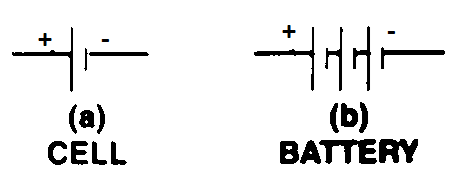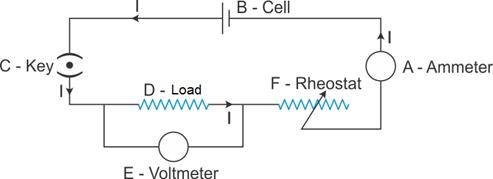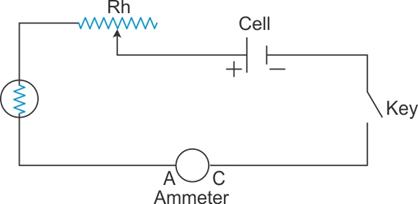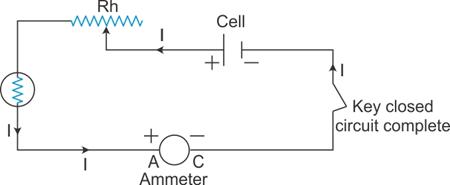Class 9 SELINA Solutions Physics Chapter 9: Current Electricity
Current Electricity Exercise Ex 9(A)
Solution A.1
(b) provide current in a circuit
Solution A.2
(c) chemical, electrical
Solution A.3
(d) electrical, chemical
Solution A.4
(c) irreversible, reversible
Solution A.5
(d) none of the above
Solution A.6
d) normal to the direction of
Current is the rate of flow of charge across a cross-section normal to the direction of the flow of current.
Solution A.7
(c) electrons
Solution A.8
(c) ne/t
I = ne/t
Solution A.9
(c) opposite
Solution A.10
(d) both (b) and (c)
Solution A.11

Solution A.12
(c) rheostat
Solution A.13
(d) variable resistance
Solution A.14
(c) ammeter
Solution A.15
(b) galvanometer
Solution A.16
(a) no free, large number of free
Solution A.17
(d) silk
Solution A.18
(d) insulator
Solution A.19
(a) Pure water
Solution A.20
(d) all of these
Solution B.1
Source of D.C.: Cell
Source of A.C.: Mains
Solution B.2
An electric cell is a device which converts chemical energy into electrical energy. When connected in a circuit, it acts as a source of D.C. current.
Solution B.3
Chemical energy changes into electrical energy.
Solution B.4
Constituents of cell: Two electrodes and an electrolyte in a vessel.
Solution B.5
Two kinds of cells:
(a) Primary cell: e.g. Leclanche cell
(b) Secondary cell: Lead (or acid) accumulator
Solution B.6
Charge on an electron is -1.6 x 10-19 coulomb.
Solution B.7
Current, I = ![]()
Solution B.8
A rheostat is used to control current in an electric circuit.
Solution B.9
A key or switch is used to put on or off, the current in the circuit.
Solution B.10
Copper wire, acidulated water and human body and mercury.
Solution C.1
Primary cells are cells which provide current as a result of irreversible chemical current.
Examples: Simple Voltaic cell and Leclanche cell.
Solution C.2
Secondary cells are cells which provide current as a result of reversible chemical reactions. It converts electrical energy into chemical energy when current is passed in it (i.e. during charging), while it converts chemical energy into electrical energy when current is drawn from it (i.e., during discharging).
Example: Lead (or acid) accumulator.
Solution C.3
Current is the rate of flow of charge across a cross-section. It is a scalar quantity.
Its S.I. unit is ampere (coulomb per second).
If 1 ampere current flows through a conductor, it means that 6.25 x 1018 electrons pass in 1 second across that cross-section of conductor.
Solution C.4
The substances which allow electric current to flow through them easily are called conductors. Examples: Impure water and metals.
The substances which do not allow the electric current to flow through them are called insulators. Examples: Rubber and wood.
Solution C.5
Conductors have a large number of free electrons and they offer a very small resistance in the path of current but insulators have no free electrons and they offer a very high resistance in the path of current.
Solution C.6
For an electric circuit to be closed, every part of it must be made of conductors.
Solution C.7
When a large direct current is required, we join a number of cells together in series (cathode of one cell connected to the anode of another cell) to form a battery or we use a storage cell.

Solution C.8
A resistance wire used in resistance box is made from alloy called manganin. The reason behind using this alloy in making of the resistance wire is that it has a fixed resistance depending upon its length and thickness and does not vary depending upon the change in temperature.
Solution C.9
The voltmeter and ammeter are used to measure the magnitude of potential difference and current respectively. They have calibrated dial on which deflection of needle shows their magnitude.
Galvanometer is used to detect the presence of the current in the circuit and the deflection of needle on the either side of '0' mark (on the middle) indicates the direction of current flow.
Solution C.10
An appliance which is connected in an electrical circuit is called load. A load may be either a resistance or a combination of different electrical components.
Solution D.1
Direct current (D.C.) is a current of constant magnitude flowing in one direction but alternating current (A.C.) is a current which reverses its magnitude and direction with time.
Solution D.2
A circuit is said to be closed when every part of it is made of a conductor and on plugging in the key or on being complete, current flows through the circuit.
A circuit is said to be open when no current flows through it. It can happen when the key is not plugged in or when any one of its components is not made of a conductor or when the circuit is broken.

Solution D.3
|
Primary Cell |
Secondary cell |
|
1. Chemical reaction is irreversible. 2. Only chemical energy is converted into electrical energy when current is drawn from it. 3. It cannot be recharged and its internal resistance is high. |
1. Chemical reaction is reversible. 2. It converts electrical energy into chemical energy when current is passed in it (i.e., during charging), while converts chemical energy into electrical energy when current is drawn from it (i.e., during discharging). 3. It can be recharged and its internal resistance is low. |
Solution D.4
(i) Key symbol: ![]() ; It is used to switch the current on or off in the circuit.
; It is used to switch the current on or off in the circuit.
(ii) Cell symbol: ![]() ; It acts as a source of direct current for the circuit.(iii) Rheostat symbol:
; It acts as a source of direct current for the circuit.(iii) Rheostat symbol: 
It is used to control the current in the circuit.
(iv) Ammeter :  ; It is used to measure the current flowing through the circuit.
; It is used to measure the current flowing through the circuit.
(v) Voltmeter:  ; It is used to measure the potential difference between two points of a circuit.
; It is used to measure the potential difference between two points of a circuit.
Solution D.5
A: Ammeter - It measures the current flowing through the circuit.
B: Cell - It acts as a source of direct current for the circuit.
C: Key - It is used to put the current on and off in the circuit.
D: Load - It is an appliance connected in a circuit. It may just be a resistance (e.g., bulb) or a combination of different electrical components.
E: Voltmeter - It is used to measure the potential difference between two points of a circuit.
F: Rheostat - It is used to control the current in the circuit.

Solution D.6
(a)

(b)

(c) A rheostat is used to control the current in the circuit.
Solution E.1
I =?
Q = 0.5 C, t =5s
I = Q/t
I= 0.5/5 = 0.1 A
Solution E.2
I = 1.5A,
t= 2s, q=?
I = Q/t
Thus,
Q = 1.5 × 2 = 3 C
Amount of charge passing through the conductor is 3 Coulomb.
Solution E.3
From the given data,
Q = 24 C
t = 0.8 s
Assuming that you need to calculate current.
Current = charge /time = Q/t = 24/0.8 = 30 A
Thus, the current in the coil is 30 A.
Current Electricity Exercise Ex 9(B)
Solution A.1
(b) A to B
Solution A.2
(a) as a source of electrons
Solution A.3
In direction from high potential to low potential.
Solution A.4
(b) lower, higher
Solution A.5
(c) zero
Solution A.6
(b) volt
Solution A.7
(d) Both (a) and (b)
Solution A.8
(a) Decreases
Solution A.9
(c) more
Solution A.10
(a) less
Solution A.11
(c) increases
Solution A.12
(c) 1 ohm
By Ohm's law we know,
V = IR
2 = 2 × R
R = 1 ohm
Solution B.1
(a) Volt
V = W/q
Where,
V - Voltage
W - Work done
q - charge
Thus, 1 V = 1J/1C
(b) Ampere
I = q/t
Where,
I - current
q - charge
t - time
Thus, 1 A = 1C/1s
Solution B.2
A battery is connected in a circuit to generate electricity.
Solution B.3
If the wire is stretched it becomes thinner and longer. Longer wire means the electrons have to travel larger distance in a wire, therefore long wire will offer more resistance.
Resistance of wire is directly proportional to length of wire.
Solution B.4
According to Ohm's law, current flowing through a conductor is directly proportional to the potential difference applied across its ends provided its temperature remains constant.
Thus, if the potential difference across the conductor increases then the current also increases and if potential difference across the conductor decreases then the current also decreases.
Solution B.5
(i) Potential difference (ii) charge (iii) resistance (iv) current.
Solution B.6
Current always flows from high potential to low potential.
Solution B.7
Electric potential difference is the difference in electric potential (V) between the final and the initial location when work is done upon a charge to change its potential energy. In equation form, the electric potential difference is
![]()
Solution B.8
S.I. unit of potential difference is volt (joule per coulomb).
Potential difference between two points is said to be 1 volt if work done in transferring 1 coulomb of charge from one point to the other point is 1 joule.
Solution B.9
The S.I. unit of resistance is 'ohm' (volt per ampere).
The resistance of a conductor is said to be 1 ohm if a current of 1 ampere flows through it when the potential difference across it is 1 volt.
Solution B.10
Ohm's law states that the electric current flowing through a metallic wire is directly proportional to the potential difference V across its ends provided its temperature remains the same.
Solution B.11
Potential difference = Current x Resistance
i.e., V = I R
Solution B.12
The temperature of the filament increases when it glows. So, when the temperature of the wire (bulb filament) increases, ions in it vibrate violently. As a result, the number of collisions increases and hence the resistance increases.
Solution C.1
The obstruction offered to the flow of current by the filament or wire is called its electrical resistance.
Solution C.2
V = IR or, I = V/R….(i)
If R is doubled,
Then, I' = V/2R = I/2……………(ii)
From (i) and (ii), it is clear that current will be halved.
Solution C.3
When both the conductors are joined by a metal wire:
(i) Electrons will flow from A to B.
(ii) Current will flow from B to A.
Solution C.4
(a) Resistance of a wire is directly proportional to the length of a wire; so if the length is doubled, resistance is also doubled.
(b) Resistance of a wire is inversely proportional to the area of cross-section the wire. Thus, if radius is doubled, area increases four times and hence the resistance becomes one-fourth.
Solution C.5
Potential difference between two points is 1 volt; it means 1 joule of work is done in transferring 1 coulomb of charge from one point to the other point.
Solution C.6
The resistance of a wire is 1 ohm; it means a current of 1 ampere will flow through the wire when the potential difference across it is 1 volt.
Solution D.1
Electric potential difference between two conductors is equal to the work done in transferring a unit positive charge from one conductor to other conductor.
Solution D.2
A metal wire has free electrons which move in random directions. When the ends of the wire are connected to a cell, the electrons start moving from the negative terminal of the cell to its positive terminal through the metal wire. During their movement, they collide with the free electrons and fixed ions of the wire. This causes them to lose their speed and change their direction. As a result, the electrons slow down and slowly drift towards the positive terminal. Thus, the wire offers resistance to the flow of current (or electrons) through it.
Solution D.3
Resistance of a wire depends upon:
(i) Length of wire: Resistance is directly proportional to the length of a wire.
(ii) Area of cross-section of wire: Resistance is inversely proportional to the area of cross-section the wire.
(iii) The temperature of wire: Resistance of a wire is directly proportional to the temperature of the wire.
Solution E.1
Potential difference (V) = work done (W) / charge (q)
Or, V = 9/1.5 = 6 volt.
Solution E.2
Given, potential difference (V) = 12 V
Resistance, R = 24 Ω
Therefore, current (I) = V / R
Or, I = 12/24 = 0.5 A
Solution E.3

Solution E.4

Current Electricity Exercise Ex 9(C)
Solution A.1
(d) both (b) and (c)
Solution A.2
The most non-polluting and efficient lighting device is the LED.
Solution A.3
IEA is the short form of international energy agency.
Solution A.4
(c) light emitting diode
Solution B.1
Incandescent light bulbs were the first traditional electric device used for home lighting.
Solution B.2
LED or light emitting diodes are most efficient for lighting purposes.
Solution C.1
Two ways to save energy:
- Instead of fossil fuels, other renewable sources of energy such as the biogas prepared from animal dung should be used.
- The use of hydroelectric energy, wind energy etc. should be given priority.
Solution C.2
By properly insulating a home, it is possible to maintain a comfortable temperature inside. It will reduce the cost of heating devices in winter and cooling devices in summer.
Solution C.3
CFL bulbs (compact fluorescent lights) saves 67% energy and they may last 6 to 10 times longer than incandescent lights.
Solution C.4
Stars on the electrical appliance indicates the efficiency of that appliance. More number of stars indicates that the appliance uses significantly less energy than other appliances.
An appliance with 1-star rating indicate that it is least efficient while 5-star rating appliance indicates that it is most efficient.
Solution D.1
Efficient use of energy means to reduce cost and amount of energy to be used to provide us the various products and services.
Solution D.2
i. A geographical location, surroundings and architectural feature of a building plays an important role in regulating its temperature and illumination.
ii. Proper placement of windows and skylights and use of architectural features which allow the natural light to reflect into the building reduces the need of artificial lighting.
iii. White roof systems save more energy in summers.
Solution D.3
Modern appliances like refrigerators make use of significantly less energy than older appliances as they have star rating according to their efficient use of electricity. Higher the star rating, higher is the efficiency.
Solution D.4
Three ways to use energy efficiently:
- The use of compact fluorescent lights (CFL) saves 67% energy and may last 6 to 10 times longer than the incandescent lamps.
- The use of advanced boilers and furnaces in industry can save sufficient amount of energy in attaining high temperatures while burning less fuel. Such technologies are more efficient and less polluting.
- The fuel efficiency in the vehicles can be increased by reducing the weight of the vehicle, using the advanced tyres and computer controlled engines.
Solution D.5
The following social initiatives need to be taken:
- Public awareness can be improved through mass-media and children's participation in campaigns and eco-club activities.
- Community involvement need to be done to reduce the misuse of electricity.
- NGO's can be used to create social awareness of the sensitive use of resources.
